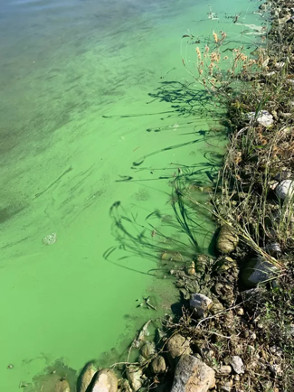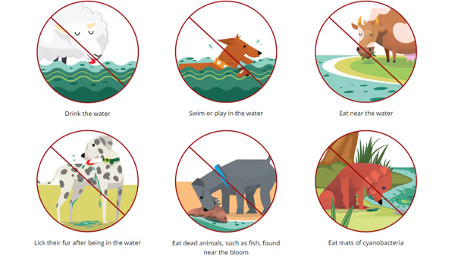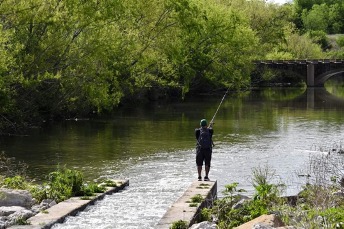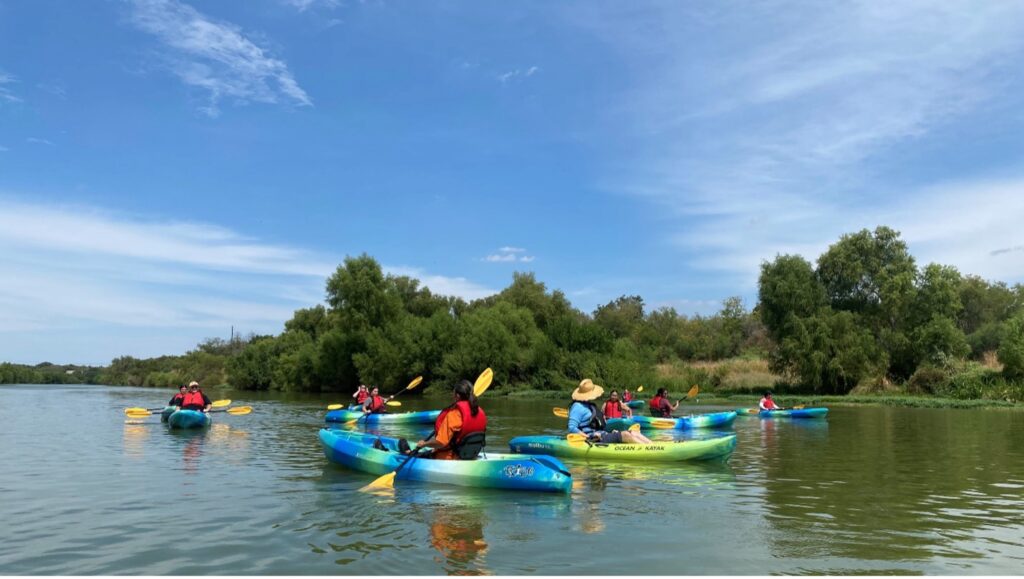We’re back with Part 2 of Staying Safe on the San Antonio River. We explored kayaking safety tips in part one, and now it’s time to examine things from a microscopic perspective.
If you choose to kayak, fish, or swim in or on Texas lakes or rivers this summer, there are two organisms you should be mindful of. No, they are not zebra mussels or apple snails but two tiny critters invisible to our naked eye: cyanobacteria and harmful amoeba. Keep reading to learn how to identify where these organisms might occur and what you can do to stay safe.
Sayonara (goodbye) cyanobacteria!

Amistad National Recreation Area – Photo Credit: National Park Service
Let’s first dive in with cyanobacteria, also known as blue-green algae. These plant-like organisms live in our water, and in certain conditions can grow quickly, resulting in an algal bloom. Because some of the blooms produce toxins, they can harm not only aquatic life but humans and their pets if touched, ingested, or inhaled. Possible severe health issues can develop by coming into contact with these harmful blooms and they can be especially deadly for pets. However, believe it or not, this can all be prevented if you know where it lives and environmental conditions that cyanobacteria thrive in!
Where can you find it? Blue-green algae can be found in rivers, ponds, lakes, hot springs, and oceans. When in doubt, avoid warm, slow-moving or stagnant water where cyanotoxins are more likely to accumulate. If you or your pet really need to cool off, clear, swift-moving water is your safest way to beat the summer heat.
What causes blue-green algae to develop? Warm/Extreme heat, high concentrations of nutrients like nitrogen and phosphorus from stormwater runoff, excess salt, stagnant water, drought, and large amounts of sediment can all lead to algal blooms.
What are some visual signs that blue-green algae is present? Foam or scum on the surface of the water, or water colored green, blue, red, and brown, may indicate that cyanobacteria are present. However, you cannot determine if a cyanobacteria bloom is toxic by just looking at it. That is why the San Antonio River Authority is in the research and development stage of monitoring cyanobacteria so that our families and animals will be safe this summer!

Protect your pets from harmful algae, cyanobacteria, or their toxins.
Watch out for the “fowl” water

Our second organism, Naegleria fowleri, known commonly as the brain eating amoeba, is a free-living and heat-loving amoeba that is found in stagnant, warm freshwater environments. It can cause a rare and often fatal infection known as primary amoebic meningoencephalitis (PAM). However, the only way to become infected is by the amoeba entering the body through the nose. Like blue-green algae, an infection can be prevented if you know where the brain eating amoeba lives and the environmental conditions that it thrives in.
Where can you find it? Rivers, lakes, hot springs, riverbed soil/mud, and untreated swimming pools (low chlorine levels).
What environmental conditions does it prefer? Warm/Extreme temperatures (80-115 degrees Fahrenheit), stagnant water, high turbidity/sediment, and drought conditions.
Has the amoeba ever been found in the San Antonio River Watershed? The River Authority is not currently testing for the amoeba. However, Dr. Siderovski, a pharmacology and neuroscience professor at the University of North Texas Health Science Center at Fort Worth stated in a recent article that “We should assume that all Texan freshwater sources — our lakes, our rivers, the Brazos, the Rio Grande, et cetera — we should assume that we have it all the time.”
The best way to protect yourself from an infection is by:
- Avoiding water-related activities in stagnant, warm freshwater.
- If you choose to swim, wear nose plugs, or keep your head above water.
- Avoid agitating digging or stirring up riverbed sediment.
- Clearing sinuses with distilled water instead of tap water.
In addition to the steps above, we need to continue furthering our knowledge to prevent cases from occurring. For more information, visit the CDC website, and remember, watch out for the “fowl” water!

There are, and will continue to be, risks associated with recreating in an outdoor body of water, be it a creek, river, lake, or ocean. Even if you are not personally interested in swimming or wading in the San Antonio River, or any other water body this summer, it is the opinion of the River Authority that each resident of the basin helps improve the quality of our local Texas waterways! Here are some ways you can help today.
Stay safe and we’ll see you on the river!




